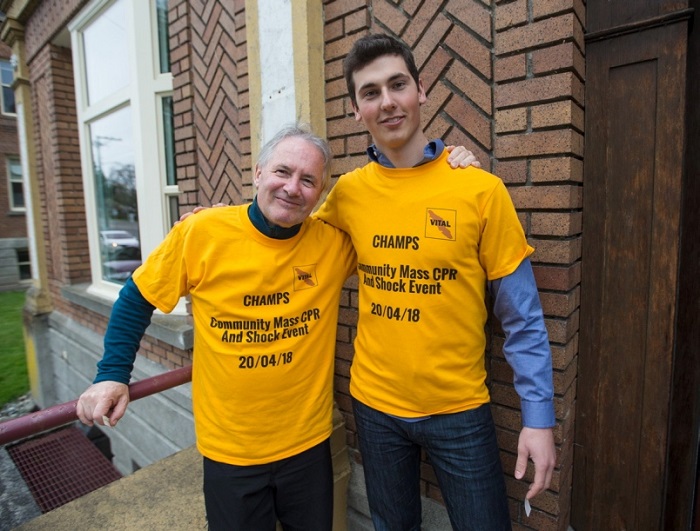How CPR Training Can Save Lives — and Spawn New Friendships

Cameron Murray, left, and Michael Wojtas at the Community Mass CPR and Shock Event. Wojtas, who knows CPR, is credited with helping to save Murray's life at the Mount Washington ski resort ion February 2016. (Photograph by Darren Stone, Times Colonist)
Michael Wojtas says when he rode up the ski lift for his last run at Mount Washington ski resort on Feb. 5, 2016, intuition told him a man slumped over on the hill below was in trouble.
By the time the lifeguard, then 18, skied to the man’s side, there was no doubt: Cameron Murray, then 61, was “jean-coloured blue.”
Panic lasted only seconds — then training and adrenalin kicked in. Wojtas dropped to the ground and started rhythmically pumping his straight arms on Murray’s chest.
“I just acted.”
Ski patrol and Victoria emergency room physician Dr. Tina Webber, also skiing that day, joined to help. Murray’s life was saved.
“Michael is my hero,” Murray said.
On Feb. 5, 2017 — a year after fate, compassion and CPR training brought Wojtas and Murray together — they skied that same hill on Mount Washington. They’ve pledged to make an annual ski trip to honour the gift of life they shared.
Their story was one of two shared with participants of a free one-hour class on Friday called a Community Mass CPR and Shock Event, offered by Vancouver Island Teachers of Advanced Cardiac Life (VITAL) in collaboration with Island Health and the Heart and Stroke Foundation of Canada and supported by B.C. Emergency Health Services.
Course instructors demonstrated how to deliver hands-only cardio pulmonary resuscitation — which removes mouth to mouth and focuses on chest compressions — and how to use an automatic external defibrillator or AED.
“It’s really, really simple,” said Peter Thorpe of the B.C. Ambulance Service.
About 100 people packed each of three sessions on Friday, using rubber dummies to learn the pressure and rhythm needed to kick-start a person’s heart.
Orissa Henderson, 50, said: “I wouldn’t forgive myself if I hadn’t taken the time to take a course like this” and someone needed CPR.
Signs of a heart attack are shortness of breath, chest discomfort, sweating and nausea. CPR is needed when a person goes into cardiac arrest and there is no breathing or only gasping, no movement, and no pulse.
Webber explained a heart attack as a “circulation” problem, while sudden cardiac arrest is an “electrical” problem.
She noted U.S. statistics saying 89 per cent of people who go into cardiac arrest outside of hospital die because they do not get CPR. Participants were encouraged to download an app called PulsePoint, which sends out an alert to people within 400 metres of a victim as soon as 911 dispatchers indicate that they have received a call. If there is a public-access defibrillator nearby, the app will also indicate where it is.
The other story shared Friday was that of Roger and Jane Bailey, both 63, of Oak Bay.
Just over two years ago, the dental surgeon turned over in bed to gently rustle his wife out of what he thought was a bad dream. When her body seemed rigid he turned on the light to see her face was a “ghastly” shade of blue.
Roger Bailey called 911 and started hands-on CPR. Emergency call-takers “metronomed” him through the timing needed to pump his wife’s heart back into action until paramedics arrived.
Emotional on Friday, Roger Bailey said life now with his wife and their children and grandchildren is richer knowing what they could have lost: “We just appreciate every day we have now.”
Story Credit: http://www.timescolonist.com/news/local/how-cpr-training-can-save-lives-and-spawn-new-friendships-1.23275913


